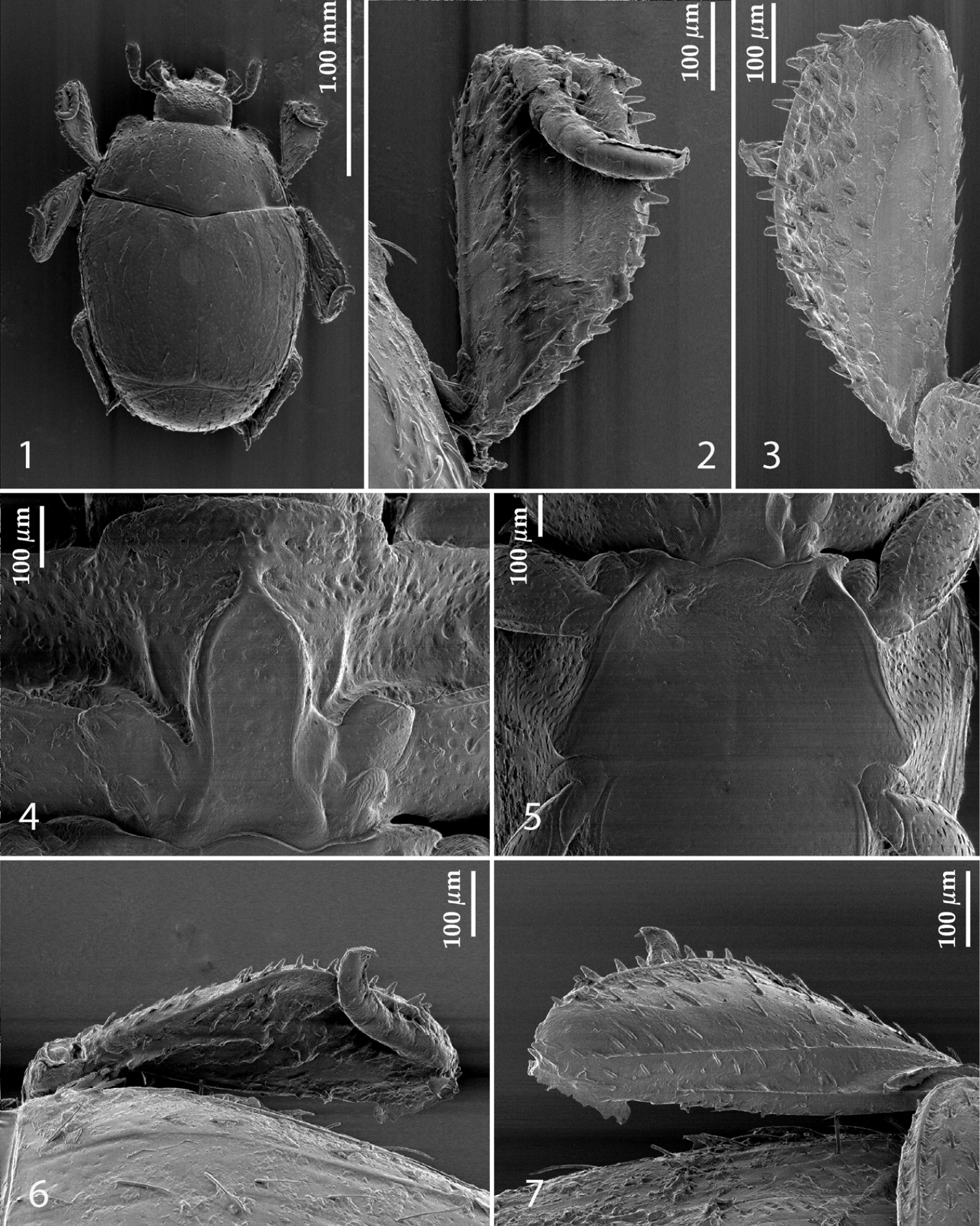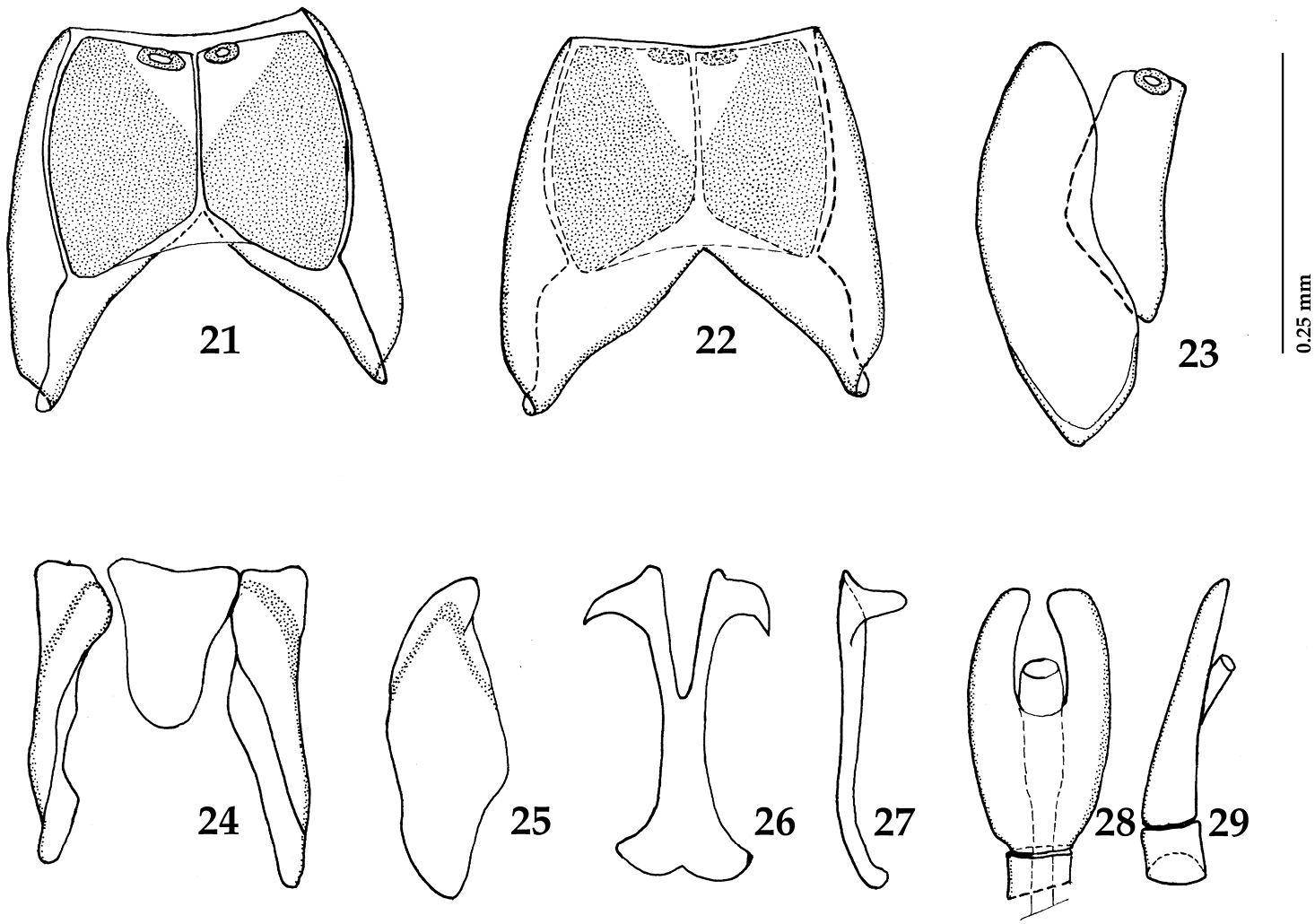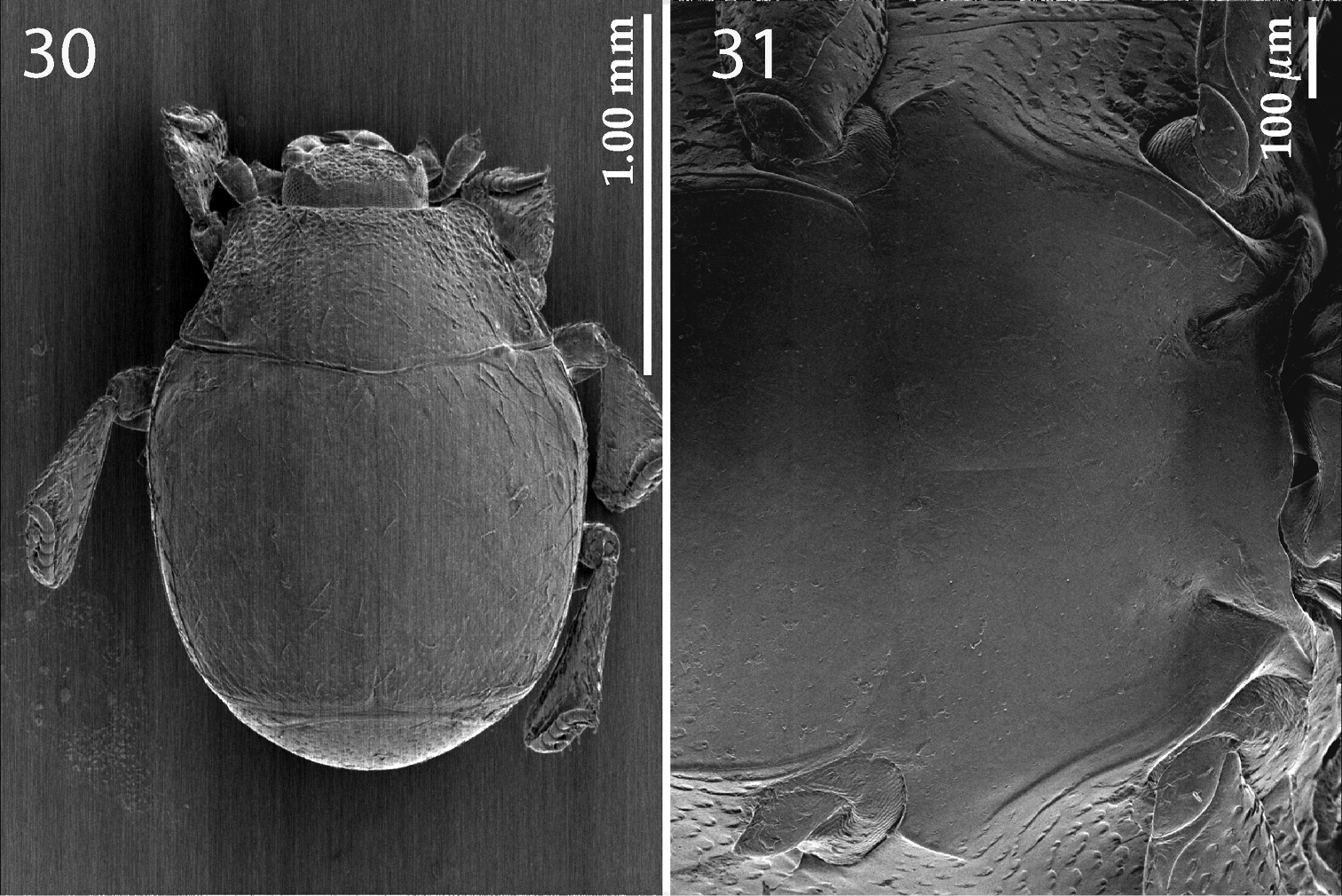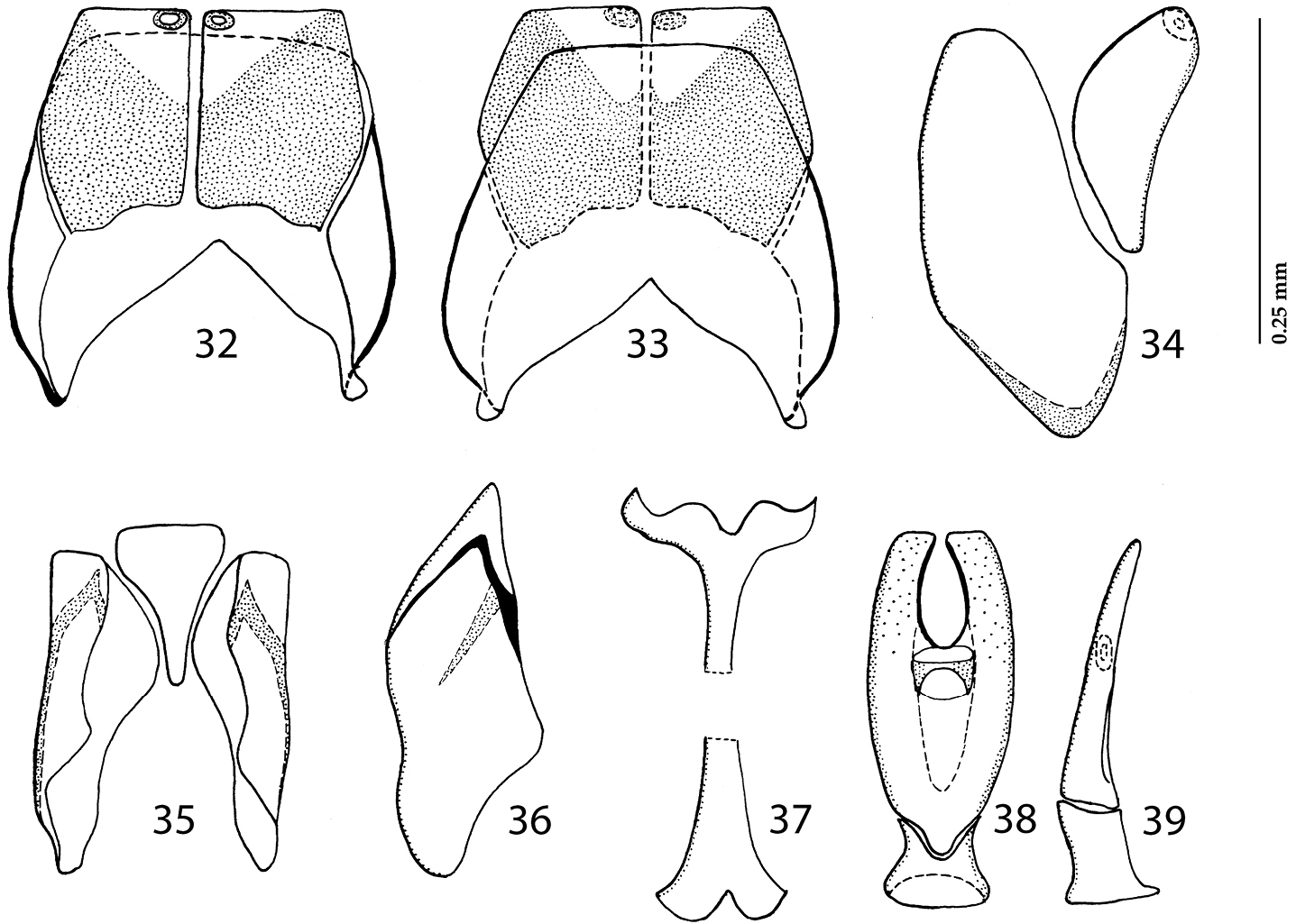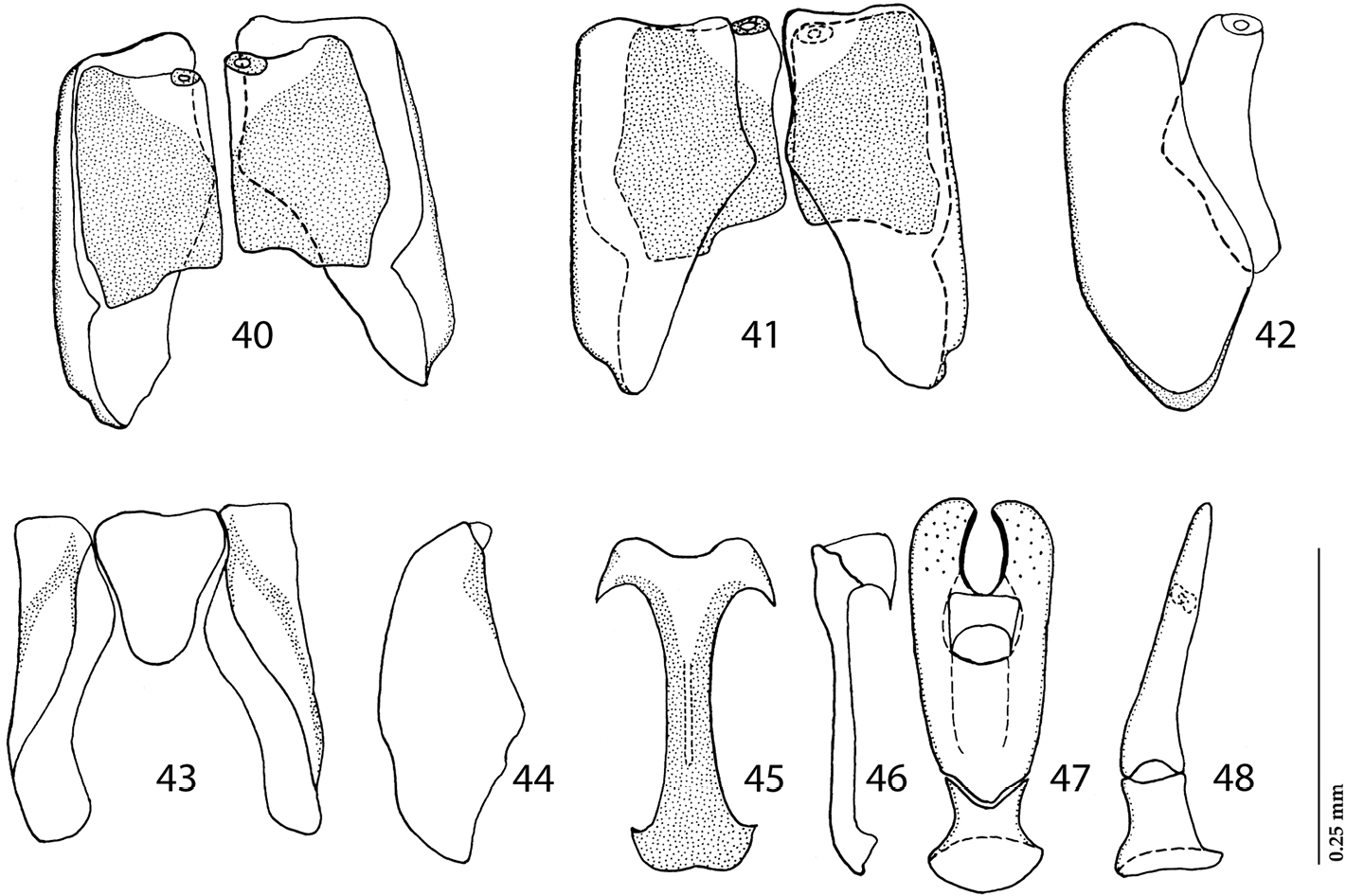






(C) 2012 Tomáš Lackner. This is an open access article distributed under the terms of the Creative Commons Attribution License 3.0 (CC-BY), which permits unrestricted use, distribution, and reproduction in any medium, provided the original author and source are credited.
For reference, use of the paginated PDF or printed version of this article is recommended.
TheSternocoelis marseulii species group is proposed based on antennal and prosternal characters. Five species are included in the group:Sternocoelis marseulii (Brisout de Barneville, 1866)(Spain), Sternocoelis viaticus Lewis, 1892 (Algeria), Sternocoelis vaucheri Lewis, 1896 (Morocco), Sternocoelis berberus Lackner & Yélamos, 2001 (Morocco)and Sternocoelis yelamosi sp. n. (Morocco). The external morphology of Sternocoelis yelamosi sp. n. is described and illustrated, the illustrations of genitalia of all species of the group (except for Sternocoelis vaucheri) are provided and a key to the species of the group is given.
Coleoptera, Histeridae, Haeteriinae, Sternocoelis, new species, Morocco, Spain, Algeria
The genus Sternocoelis Lewis, 1888 is a small genus of myrmecophilous histerids with 27 described species distributed in the Mediterranean area with most species described from Morocco and Algeria (
Beetles, after being removed from original cards, were side-mounted on triangular points and examined under Nikon 102 binocular microscope with diffuse light. Male genitalia were first macerated in 10% KOH solution for about 15 minutes, cleared in 80% alcohol and macerated in lactic acid with fuchsine heated up to 60°C for another two hours. After that, they were treated with aceto-salycilate heated up to 60°C for 15 minutes and cleared in xylene. They were subsequently examined in α-terpineol in a small dish. Digital photographs were taken by a Nikon 4500 Coolpix camera and edited in Adobe Photoshop CS3. Based on the photographs, observing the actual genitalia, pencil art was drawn; pen art followed, re-tracing the pencil art and making minor corrections. SEM photographs were taken by Hitachi S-2250N camera.
The following acronyms of museums and private collections are used throughout the text:
BMNH The Natural History Museum, London, United Kingdom (R. Booth);
CTLA Tomáš Lackner collection, Leiden, The Netherlands;
CTYB Tomás Yélamos collection, Barcelona, Spain;
MNHN Muséum National d’Histoire Naturelle, Paris, France (A. Taghavian).
AbbreviationsAbbreviations of morphological measurements follow
APW width between anterior angles of pronotum
EL length of elytron along elytral suture
EW maximum width between outer margins of elytra
PEL length between anterior angles of pronotum and apices of elytra
PPW width between posterior angles of pronotum.
Separate lines of the same label are marked by slash (/); separate labels are marked by double slash (//). Morphological conventions and terminology and methods of illustration preparation follow
All members of the group can easily be distinguished from all other Sternocoelis by the combination of the following character states:
1. prosternal lobe at the same level or slightly below the level of prosternal keel;
2. prosternal lobe not divided medially and without deep emargination;
3. prosternal keel with carinal prosternal striae distinct and (almost) joined anteriorly;
4. elytra with first dorsal elytral stria complete;
5. antennal scape with a ‘hook’ (except for Sternocoelis viaticus).
| 1 (8) | Antennal scape with a ‘hook’ (Fig. 20) | |
| 2 (3) | Prosternum, especially apically, weakly punctate (Fig. 4) | Sternocoelis yelamosi sp. n. (Morocco: Jebel Tazzeka) |
| 3 (2) | Prosternum apically very coarsely and densely punctate, rugose (Fig. 17) | |
| 4 (5) | Pronotal sides strongly explanate (see |
Sternocoelis berberus Lackner & Yélamos, 2001 (Morocco: High Atlas) |
| 5 (4) | Pronotal sides weakly explanate, not well separated from the disc (Fig. 30), body size 1.30–1.40 mm. | |
| 6 (7) | Anterior pronotal angles strongly produced, elytra along widest point rather narrow, ratio width: length 1.14 (Fig. 18), meso-metaventral excavation deep (Fig. 19) | Sternocoelis marseulii (Brisout de Barneville, 1866) (Spain) |
| 7 (6) | Anterior pronotal angles weakly produced, elytra along widest point rather broad, ratio width : length 1.20 (Fig. 30), meso-metaventral excavation shallow (Fig. 31) | Sternocoelis vaucheri Lewis, 1896 (Morocco: Tangier) |
| 8 (1) | Antennal scape without a ‘hook’ | Sternocoelis viaticus Lewis, 1892 (Algeria) |
urn:lsid:zoobank.org:act:6E3C4ACC-F2D0-44F6-8BA0-303324D266A7
http://species-id.net/wiki/Sternocoelis_yelamosi
Figs 1–16Morocco, Jebel Tazzeka.
Holotype, ♂: MOROCCO: Moyen Atlas / Taza: Jebel Tazzeka / N34°12.226', W04°03.908' / 11.V.2009 / Hlaváč lgt., under stone with ants, 1360 m (printed); // HOST ANT: Aphaenogaster mauritanicus Emery / H. Cagniant, det. 2009 (printed); // HOLOTYPE Sternocoelis yelamosi Lackner & Hlaváč, det. 2010 (red label, printed); CTLA. Note. One specimen of minor worker ant is pinned together with the holotype.
PEL:1.425; APW:0.625; PPW:1.075; EL:0.875; EW:1.20. Body (Fig. 1) colour reddish-brown, shiny, weakly convex, oval, dorsal surface with sparse setation, ventral surface lacking setae.
Sternocoelis yelamosi sp. n. 1 habitus dorsal view 2 protibia dorsal view 3 ditto, ventral view 4 prosternum 5 meso-metaventrite 6 mesotibia, dorsal view 7 ditto, ventral view.
Frons wide, almost rugulose-lacunose, coarsely punctate, punctures with sparse setae; eyes well-visible from above; frontal stria carinate, prolonged onto clypeus; antennal scape thickened, apically with a ‘hook’, antennal club cylindrical, truncate at apex.
Pronotum with dense fine punctulation anteriorly and evanescent punctulation laterally and basally, with sparse setae (many setae probably worn off); pronotal sides weakly separated from disc by shallow marginal depression; marginal pronotal stria present on basal three-quarters; anterior pronotal angles produced, truncate; posterior angles of pronotum acute, not produced.
Elytra weakly convex, with long but sparse setae; disc densely punctate, punctures separated by several times their diameter; marginal elytral stria complete, carinate, briefly continued as apical elytral stria; first dorsal elytral stria complete, second dorsal elytral stria reaching approximately two-thirds of elytral length apically, third elytral stria the shortest, fine, reaching approximately mid elytral length apically, other elytral striae absent.
Propygidium about 2.5 times as long as pygidium, both with sparse punctulation and sparse long setae.
Prosternal process (Fig. 4) at slightly higher level than prosternal lobe; carinal prosternal striae bisinuate, joined anteriorly, interspace between them rugose; prosternal lobe roughly punctulate.
Mesoventrite smooth, shiny, asetose; meso-metaventral depression shallow; mesoventral foveae incipient (Fig. 5); three lateral mesoventral striae present; inner one middle of mesoventrite posteriorly. Metaventrite with sparse and fine punctulation present mainly in anterior part, shiny.
All visible abdominal sternites smooth, asetose, second visible abdominal sternite medially about twice as long as sternite I and III.
Legs (Figs 2–3, 6–7) relatively short, with sparse but strong setae, all tibiae expanded from base to apex, with strong setae, mainly on outer margins.
Male genitalia. Eighth sternite (Figs 8–9) longitudinally divided medially, apically without velae, each half of divided eighth sternite apically with round sclerotized ‘ring’; eighth tergite much larger than sternite, longitudinally almost divided medially, its halves widely separated; eighth sternite and tergite completely separated laterally (Fig. 10). Ninth tergite (Figs 11–12) widely separated by tooth-shaped tenth tergite. Spiculum gastrale (Figs 13–14) dilated on both ends, apical end dilated, with medio-apical notch. Aedeagus (Figs 15–16) typical for the genus (see
Sternocoelis yelamosi sp. n. male terminalia. 8 Eighth sternite and tergite, ventral view 9 ditto, dorsal view 10 ditto, lateral view 11 ninth and tenth tergites, ventral view 12 ditto, lateral view 13 spiculum gastrale, ventral view 14 ditto, lateral view 15 aedeagus, dorsal view 16 ditto, lateral view.
Sternocoelis yelamosi sp. n. closely resembles other species included in the Sternocoelis marseulii species group, but it can be differentiated from all of them as follows: from Sternocoelis viaticus by presence of ‘hook’ on antennal scape [lacking only in Sternocoelis viaticus]; from Sternocoelis marseulii by weaker punctation of the prosternum and coarser punctation of dorsum [prosternum of Sternocoelis marseulii is rugose and densely punctate; dorsum with weaker punctation]; from Sternocoelis vaucheri by weaker punctation of the prosternum and coarser punctation of elytra [prosternum of Sternocoelis vaucheri is rugose, coarsely punctate and elytra are almost impunctate]: from Sternocoelis berberus by smaller body size [1.425 vs. 1.60 mm in Sternocoelis berberus] as well as by weakly explanate pronotal sides [pronotal disc of Sternocoelis berberus is clearly separated from strongly explanate pronotal sides].
Patronymic, named after and dedicated to our friend Tomás Yélamos (Barcelona, Spain), who revised the genus Sternocoelis and confirmed this to be a new species.
So far known only from the type locality, Jebel Tazzeka in Middle Atlas, northeast Morocco.
Aphaenogaster mauritanicus Dalla Torre, 1893.
Sternocoelis berberus Lackner &Yélamos, 2001: 26 exs (sex undetermined): Morocco, Oïkameden, 2646m - 2656m (N31°11.605', W07°51.172' – N31°11.609', W07°51.168'), 20.V. 2009, P. Koniar & M. Švarc lgt., under rocks on open slope.
Sternocoelis viaticus Lewis, 1892: Paralectotype, ♂, side-mounted on a triangular point with dismembered genitalia glued to the same triangular point as specimen, with another mounting card bearing an ant, with written label: „Meskoutin / G. Lewis / 22.4.[18]92“, followed by another written label „Sternocoelis / viaticus / Co-Type Lewis“, followed by round, yellow-margined label „Co- / type“ and by another printed label „G. Lewis Coll. / B.M. 1926-369“, followed by another red label, printed „Paralectotypus / T. Yélamos / Des. 1993“.
Sternocoelis marseulii (Brisout de Barneville, 1866): 2 ♀♀ & 2 ♂♂ Spain, Escorial (MNHN).
Sternocoelis vaucheri Lewis, 1896: Paralectotype, ♂, side-mounted on a triangular point with dismembered genitalia glued to the same triangular point as specimen (spiculum gastrale missing), with another mounting card bearing an ant, with written label: „Tanger / 1896 / Vaucher“, followed by another written label: „Much more / convex than / Marseulii Bris.“, followed by printed label: „G. Lewis Coll. / B.M. 1926-369“, followed by another printed label: „Sternocoelis / vaucheri / Lewis, 1896 / T. Yélamos Det.“, followed by another red label, printed „Paralectotypus / T. Yélamos / Des. 1993“ (BHMN).
Sternocoelis yelamosi shares numerous character states with another four species (Sternocoelis vaucheri, Sternocoelis berberus, Sternocoelis viaticus and Sternocoelis marseulii) that are found in Morocco, Algeria and Spain, respectively. Most of these character states, according to the phylogenetic analysis performed by
Sternocoelis marseulii (Brisout de Barneville, 1866). 17 prosternum 18 habitus, dorsal view 19 meso-metaventrite 20 head, dorsal view.
Sternocoelis marseulii (Brisout de Barneville, 1866) male terminalia. 21 Eighth sternite and tergite, ventral view 22 ditto, dorsal view 23 ditto, lateral view 24 ninth and tenth tergites, ventral view 25 ditto, lateral view 26 spiculum gastrale, ventral view 27 ditto, lateral view 28 aedeagus, dorsal view 29 ditto, lateral view.
Sternocoelis vaucheri Lewis, 1896. 30 habitus, dorsal view 31 meso-metaventrite.
Sternocoelis berberus Lackner & Yélamos, 2001, male terminalia. 32 Eighth sternite and tergite, ventral view 33 ditto, dorsal view 34 ditto, lateral view 35 ninth and tenth tergites, ventral view 36 ditto, lateral view 37 spiculum gastrale, ventral view 38 aedeagus, dorsal view 39 ditto, lateral view.
Sternocoelis viaticus Lewis, 1892, male terminalia. 40 Eighth sternite and tergite, ventral view 41 ditto, dorsal view 42 ditto, lateral view 43 ninth and tenth tergites, ventral view 44 ditto, lateral view 45 spiculum gastrale, ventral view 46 ditto, lateral view 47 aedeagus, dorsal view 48 ditto, lateral view.
We are grateful to our colleague and friend Tomás Yélamos (Barcelona, Spain) for his time to verify the identity of this new species as well as for his help with the myrmecophilous histerids of Morocco in general. Thanks are due to the curators of the above-mentioned institutions for their help with the specimens as well as to J. Cooter (Oxford, UK) for the grammatical revision of the manuscript.
Open access to this paper was supported by the Encyclopedia of Life (EOL) Open Access Support Project (EOASP).
